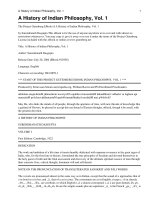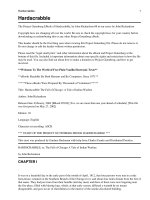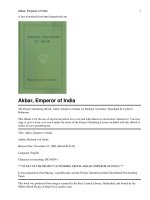Pig: Potential future meat animal of India
Bạn đang xem bản rút gọn của tài liệu. Xem và tải ngay bản đầy đủ của tài liệu tại đây (341.7 KB, 7 trang )
Int.J.Curr.Microbiol.App.Sci (2019) 8(2): 3149-3155
International Journal of Current Microbiology and Applied Sciences
ISSN: 2319-7706 Volume 8 Number 02 (2019)
Journal homepage:
Review Article
/>
Pig: Potential Future Meat Animal of India
Neha Thakur1*, Sarita Kumari1, Ashish Saini2, Priyanka Meena2,
Manaswini Sharma2 and Manoj Bunkar2
1
MVSc LPT, ICAR-Indian Veterinary research institute, Bareilly-243122, U.P., India
2
MVSc LPT, PGIVER-RAJUVAS, Jaipur- 302031, India
*Corresponding author
ABSTRACT
Keywords
Pork, Pig
Production, Pork
consumption in
India, Pork potential
in India
Article Info
Accepted:
22 January 2019
Available Online:
10 February 2019
Globally, pork is the most consumed meat but in India, consumption of pork is limited to
few regions of the country. Pigs being the efficient feed converters can solve the problem
of increasing meat demand due to population rise and also supplement the income of poor
and small/marginal farmers. Learning from the success stories of few progressive farmers,
one easily derives that piggeries are the new found gold mines and their potential is yet
untapped in our country. This review presents the SWOT analysis of pork production in
India highlighting the lacunas that exist in the production system along with the future
trends of pig farming in India.
Introduction
“Eating meat is an instinct; not eating meat is
a choice”
Human beings have come a long way from
„food-gatherer‟
to
“food-hunter”
and
eventually „food-producer‟. Today the world
food economy is parallel with the livestock
economy. Also, we look up to easy-fixed
meals like ready-to-eat (RTE) and ready-tocook (RTC) due to our busy routines and the
meat industry has a huge role to play as it
offers a wide variety of meat products.
Talking about the wide variety and giantess of
meat industry one cannot neglect the role pig
& pork play in shaping up the megaeconomies like U.S.A. Globally it is the most
accepted meat and for a progressing nation
like India whose meat industry has not yet
fully explored its potential, pork can be the
ultimate meat if its domestic and export
potential is fully exploited.
India, besides being a home to various
cultures, religions and customs of the world,
is also one of the most populous countries
across the globe. It is projected that by 2050
India would be feeding a population of 1.7
billion people and hence, the meat
3149
Int.J.Curr.Microbiol.App.Sci (2019) 8(2): 3149-3155
requirement of country is expected to soar
upto 19 millions tons against the current
production of 6.4mmt (APEDA, 2016).
Global trends
More pork is eaten in the work than any other
terrestrial meat. About 37% of all meat
consumed in the world is pork (110 million
metric tonnes, mmt), ahead of beef (67 mmt)
and chicken (104 mmt) (Table 1). In 2011,
China had about half of the world pork
production (50 mmt), and the USA was
second largest in numbers of pigs (10 mmt)
with only one-fifth as many pigs as China.
Germany was third in pork production with
half the USA level (5 mmt) (McGlone, 2013).
The EU as a whole is a significant pork
producer. Over 80% of the world‟s pork is
produced in Asia, the EU and North America
(Steinfeld et al., 2006).
domestic counterparts i.e. sheep, got, cattle
etc. with an FCR of greater than 3. (3.46 to
4.09) (David, 2012). FCR is a reflection of
performance as feeding contributes to about
70-80% of the total cost of production and
this fact can be well utilized for the upliftment
of weaker sections of society where pig can
serve as a source of cheap income. Especially,
in the northeastern regions of our country
where there is high pig population. Low or
meagre inputs can be fruitfully converted to
lucrative results by utilizing the efficient
conversion of vegetable matter into high
quality protein for human consumption.
“Riding the pigs to prosperity” is an idea that
has been well received by the progressive
farmers of certain states and their tales of
success are being used to inspire the rest of
the futuristic farmers of the nation (Mizelle,
2012).
Pork production in India
Population of the world is increasing slowly,
but it is anticipated to level in the next 30–50
years (Allen, 2011). Growth in the population
would lead to an increased demand for pork
(and other meats). Moreover, as developing
countries become more affluent, the
population shifts its diet from plant-protein
based to animal protein based (Godfray et al.,
2010). Thus, while world population may
reach 50% higher than today, world meat
consumption will likely double in the next
30–50 years (Tilman et al., 2002).
Industrialized pork production facilities
decrease in value over a 20–30 year period
and would be replaced at the end of a
depreciation cycle with new and improved
facilities. Thus, in the next decades, it is
estimated that the industrialized pork
production facilities will double in size.
Pig to pork
It is a known fact that pig is one of the most
efficient food converting animal among its
Pork production in India is growing at a
steady pace as the statistics present a grim
scenario in terms on consistent stagnancy in
total meat share of pork across the nation. Pig
is widely distributed in all the eco-regions of
the country and its rearing is an important
occupation of the rural society especially
amongst the tribal masses. People of certain
ethnic groups prefer to keep pigs, especially
black ones, for festivals and ceremonial
purposes. Pigs are concentrated in the NorthEastern Region where almost 40% of the
country‟s total pig population is reared
(Kumaresan et al., 2007). According to the
latest livestock census (19th Livestock
Census, 2012) the pig population of India is
10.29 million and is showing a declining
trend. India‟s pigs constitute about 1% of
world pig population and the piggery sector is
gaining slow but steady momentum during
the past few years. Marginal to small farmers
and landless laborers owns majority of the pig
population. Pork production in India is
3150
Int.J.Curr.Microbiol.App.Sci (2019) 8(2): 3149-3155
estimated at 464 thousand metric tons in FY
2014-15 (April-March) (GOI), which
contributes approximately 8 percent of the
country‟s animal protein sources. From FY
2009-10 to 2014-15, pork production
increased at a slow pace with compound
annual growth rate of 1.4 percent due to
population growth. According to the
Livestock Census, 2012, published by
Government of India (GOI), the pig
population declined by 7.5 percent to 10.3
million from 2007 to 2012. The decline in
population may be attributed to disease
outbreaks. The eastern and north eastern
regions of the country comprise around 63
percent of the pig population. The highest pig
population is in state of Assam (1.63 million)
followed by Uttar Pradesh (1.33 million),
Jharkhand (0.96 million), Bihar (0.65 million)
and West Bengal (0.65 million). The pork
production is concentrated mainly in the
states of Uttar Pradesh (30 percent), followed
by north-eastern states (25 percent), (Bihar
(15 percent), West Bengal (6 percent),
Karnataka (4 percent), Jharkhand (4 percent),
and Kerala (3 percent).
The majority of the pig population in India is
of indigenous breeds (76 percent) though
population of cross-bred and exotic pigs
increased by 12.7 percent from year 2003 to
2012 (Riedel et al., 2012). The exotic breed
mainly comprises Hampshire, Large White
York Shire, Duroc, Landrace, and Tamworth
while some of the popular indigenous pig
breeds include Ghungroo, Niang Megha,
Ankamali, Agonda Goan, and TanyVo.
India‟s average meat yield of indigenous
breeds is around 35 Kg/animal, which is quite
low in comparison to world average of around
78 Kg/animal (Scarpa et al., 2003).
Pork consumption in India
The per capita pork consumption in India is
negligible with the consumption mainly
concentrated in north-eastern states including
Assam, Nagaland, Arunachal Pradesh,
Manipur, Meghalaya, Mizoram, Sikkim, and
Tripura. Other Indian states with high pork
consumption include Bihar, Jharkhand, West
Bengal, Goa and Kerala. India‟s Muslim
population comprising 14.2 percent of the
total population do not eat pork due to
religious reasons. Besides, large sections of
Indians consumers are suspicious about
cleanliness of domestic pork meat as pigs are
natural scavenger; the factors further limiting
the growth of pork meat sector.
In fact, India‟s pork consumption can be
divided into two segments. First segment
being the consumption in the form of fresh
pork meat sold through unorganized wet
markets and meat vendors. The second
segment is the high value imported pork
products like sausages, ham, bacon, salami,
canned meat products and frozen meat. The
hotels and restaurants are the major buyers of
the imported pork products, which cater to
international travelers and wealthier Indian
consumers. There is also retail demand for
imported pork products amongst the welltravelled Indian consumers and foreigners
residing in India. Though imported pork cuts
are preferred for its quality, these are three to
four times more expensive than the
domestically produced pork cuts (Umberger
et al., 2002). The distribution of imported
frozen pork products and other meat products
is a major challenge due to insufficient cold
chain infrastructure across the country.
Poultry is the most preferred meat in India
which is currently experiencing a strong
growth (Kearney, 2010).
Limitations
Absence of sufficient number of pig breeding
farms in the country is a weakness for which
sufficient numbers of quality pigs are not
available for the fattener farmers as well as to
3151
Int.J.Curr.Microbiol.App.Sci (2019) 8(2): 3149-3155
the markets. Religious taboo attached with
pork consumption is also a major weakness
because of which pig farming has not
progressed well in the past and confined to a
selective group of communities. Tendency of
the pig growers to raise pigs to marketable
age on zero or negligible inputs is another
weakness. Preference of the consumers for
pork from the local pig is another weakness
for promotion of improved pig with lean meat
quality. Lack of adequate support from the
development and financial institutions to
establish pork based industries has been
hindering the growth of pig farming to the
desired extent. In the absence of supportive
industries in and around the areas where pigs
are reared, by-product utilization suffers a
setback for which economic return is less.
Inadequate availability of high performing
improved germplasm for the farmers and
entrepreneurs reduces the interest towards
commercial pig farming. High cost and more
than 60% deficiency in concentrate feed are
potential threats to the piggery sector, which
compete with human food for grains.
Occurrence of endemic diseases such as
classical swine fever and emergence of transboundary diseases like PRRS and porcine
circovirus type 2 infections also pose a major
concern for piggery sector in India. Limited
supply and cost of feed material remains as
one of the most prominent bottlenecks in
promoting pig farming in the country
(Neumann, 2012). Development of economic
resource based feeding and increasing
bioavailability of the nutrients will remain as
key challenges in promoting sustainable pig
husbandry since about 70% of the pig rearing
costs are involved on feed. Another challenge,
particularly posed due to increasing human
population and urbanisation, is the disposal of
waste originating from the piggeries.
Technological constrains and higher cost of
the disposal mechanisms restrict farmers in
proper disposal of piggery wastes, resulting in
reduced public support for organised pig
farms near human dwellings. Therefore,
development
of low
cost
effective
mechanisms for reducing odours emanating
from the pig farms along with appropriate
disposal of manure is considered most
essential in promotion of piggery sector. Non
availability of sewage disposal and by product
utilization facility particularly in areas where
pig concentration and slaughter is maximum,
is another threat from public health point of
view for which general public might offer
negative views for the growth of pig industry.
In another perspective, the challenges for the
pig husbandry sector can be subdivided as
animal factors (low productivity and growth
rate of indigenous animals, poor feed
conversion efficiency), feed factors (higher
cost of feed ingredients, shortage of feed
components, poor resource based feed
delivery
system,
reduced
nutrient
bioavailability,
competition
for
feed
components for other species), environmental
factors (incidence of diseases, emerging
diseases, climatic stress, disposal of waste
generated from pig farms) (Mapiye et al.,
2008) and market and technology transfer
factors (low availability of quality
germplasm, weak market linkages, meeting
consumer demands, safety and quality of pork
and value added products, awareness among
public, technology transfer and adoption, skill
development among stakeholders). The major
problem faced by small-holder pig farmers in
the country is the lack of critical inputs to
transform the existing low or zero input
system to a vibrant technology driven
successful enterprise. It was realized that a
small scale economic technology intervention
in the form of superior germplasm and
package of practices is required to improve
income and viability of the enterprise.
Opportunity in pig production
Pigs, being a livelihood insurance particularly
for the weaker sections of the community,
3152
Int.J.Curr.Microbiol.App.Sci (2019) 8(2): 3149-3155
there exists tremendous opportunities to use
pig as a medium of poverty alleviation in the
country. The North East in the country where
around 50% of country‟s pork is consumed by
way of procuring live pigs from other parts to
the tune of around 1.0 lakh pig heads per
annum, a very good opportunity exists for
opening
up
employment
generation
programmes for rural youth in this sector. It is
anticipated that self employment to at least
200 youths in the region would be ensured by
production of 500 weaner pigs by each of
them per annum. In addition to this, weaner
pig purchasers (fattener farmers) can get
benefited through the enhanced income
through rearing of improved pigs. Selfemployment through pork product processing
and employment generation to workers is yet
another opportunity through pig husbandry.
The current population of 10.29 million
(2012) pigs is strength to meet the animal
protein deficiency experienced in the country.
Ability of the pig to survive and produce
under adverse husbandry practices is strength
particularly for the weaker, tribal and landless
population of the country. Both organic and
leaner pork production under traditional
managements are additional strengths to bring
a meat revolution in the country and thereby
provide employment to a large section of the
rural poor. India still has significantly large
number of people below poverty line. Most of
the population are in the tribal belts of the
country, where the people are mostly nonvegetarian in their dietary habit. Pork
consumption being popular among these
populations, improved pig husbandry is an
important area in the poverty alleviation
programmes. Another opportunity will be
utilisation of pig by-products such as hair
fibre for value addition and supplementation
of existing income from pig farming.
Basic facts about pork
Pork is a high-quality protein food.
Around 20% of pork is made up of
protein, making it an important muscle
building meat (Andersen et al., 2005)
High calorific value (242kCal/100g)
A 3-ounce serving of pork is a good
source of potassium, riboflavin and
zinc, and is an excellent source of
vitamin B6, thiamin, phosphorus,
niacin and protein. Pork is naturally
low in sodium, too (Brody, 1985).
When people who were obese and overweight
switched to a high-protein diet with 25
percent of total calories coming from lean
pork and other proteins, they reported an
increased feeling of fullness throughout the
day (Van Kleef et al., 2012).
Pork Product Processing
Global
Pork Indian
Pork
Products
Products
• Wide variety
• Limited
products
• Wellestablished
• Mostly
pork firms
imported
• Corporate
• Domestic
giants
products of
involved
in
low quality
the business
• Small
progressive
• Multi-milliondollar industry
farmers and a
few
entrepreneurs
Role of Government
•
NABARD (support the State Piggery
Farms, and importation of germplasm)
•
DAHD&F (Guide in Implementing an
Effective Bio security Plan in pig farm)
With the vision 2050 of NRCP, here are a few
things that the government of India aims at
achieving 30% growth in the piggery sector.
Additional objectives include conservation of
Indigenous Pig Germplasm, development of
3153
Int.J.Curr.Microbiol.App.Sci (2019) 8(2): 3149-3155
Technologies Related to Animal Breeding and
Propagation of Improved Breeds of Pigs,
developing Novel Feeds and Technologies for
High Animal Performance. Additionally,
provision for early Disease Diagnosis,
Prevention and Decision Support Systems for
improved production is being eyed at.
Table.1 Meat amount and % consumed in the world (FAO, 2012)
Meat
Pork/Porcine
Poultry
Bovine
Ovine
Total Common Meats
Meat consumed, 2012 (mmt)
110.8
104.5
66.8
13.9
296.0
In conclusion, pig production in India holds
great prospects and assures a very bright
future. But before one can cash in upon this
global opportunity that is knocking at our
door steps we need to prepare ourselves for it.
We require excellence in pig production,
health and product processing through
innovative research in order to provide
technology backstopping for enhanced pork
production, employment generation and
poverty reduction among socially and
economically weaker sections through the
medium of pig husbandry.
We need innovative research especially
targeting technology delivery mechanisms for
rapid growth of the piggery sub-sector and
making India a dominant player among the
pig producing nations of the world. We being
the brains behind this soon-to-be-blooming
industry, we need to deliver our services
efficiently. The cutting edge research
activities in various frontier areas needs to be
directed
towards
augmenting
overall
nutritional and economic security of pig
farmers, transforming piggery to an organized
venture for enhanced income, generating
employment opportunities and acting as
engine for driving socio-economic progress
among the citizens of the country and for
environmental sustainability of pig production
system in the country.
Percentage of meat (%)
37.4%
35.3%
22.6%
4.7%
100.0%
Further, we need to offer more state-of-the-art
institutional facilities undertaking high
quality, high impact research, in pig and allied
industry, offering production support. Pig
rearing and pig product production need a
head-on approach by the stakeholders to uplift
the pig production scenario in India.
If this is done right then in no time we can
achieve household food, nutritional and
economic security through research, extension
and overall human resource development.
And make progress in food industry and
become leaders in pork production which is
without the most preferred and globally
accepted meat in the world.
References
Allen, R.C. 2011. Global economic history: a
very short introduction (Vol. 282).
Oxford University Press.
Andersen, H.J., Oksbjerg, N., Young, J.F. and
Therkildsen, M. 2005. Feeding and meat
quality–a future approach. Meat science,
70(3), pp.543-554.
Brody, J.E. 1985. Jane Brody's Good Food
Book: Living the High-carbohydrate
Way. WW Norton & Company.
David R. S. 2012. Iowa State University
Extension. IPIC 25h. Swine Feed
Efficiency: Influence of
Market
Weight.
3154
Int.J.Curr.Microbiol.App.Sci (2019) 8(2): 3149-3155
Food-Outlook-FAO,
2013.Available-online:
/>ak341e09. htm#TopOfPage (accessed
on 14 May 2013)
Godfray, H.C.J., Beddington, J.R., Crute, I.R.,
Haddad, L., Lawrence, D., Muir, J.F.,
Pretty, J., Robinson, S., Thomas, S.M.
and Toulmin, C. 2010. Food security:
the challenge of feeding 9 billion
people. Science, 327(5967), pp.812-818.
Kearney, J. 2010. Food consumption trends and
drivers. Philosophical transactions of
the royal society B: biological sciences,
365(1554), pp.2793-2807.
Kumaresan, A., Bujarbaruah, K.M., Pathak,
K.A., Chhetri, B., Das, S.K., Das, A.
and Ahmed, S.K. 2007. Performance of
pigs reared under traditional tribal low
input production system and chemical
composition
of
non-conventional
tropical plants used as pig feed.
Livestock Science, 107(2-3), pp.294298.
Mapiye, C., Mwale, M., Mupangwa, J.F.,
Chimonyo, M., Foti, R. and Mutenje,
M.J. 2008. A research review of village
chicken production constraints and
opportunities in Zimbabwe. AsianAustralian Journal of Animal Science,
21(11), pp.1680-1688.
McGlone, J.J. 2013. The future of pork
production in the world. Towards
sustainable, welfare-positive systems.
Animals 3(2):401-415.
Mizelle, B. 2012. Pig. Reaktion Books.
Neumann,
E.J.
2012.
Disease
transmission and biosecurity. Diseases
of swine. John Wiley and Sons Inc.,
Oxford, UK, pp.141-164
Riedel, Simon, Anne Schiborra, Christian
Huelsebusch, Mao Huanming, and Eva
Schlecht.
2012."Opportunities and
challenges
for
smallholder
pig
production systems in a mountainous
region of Xishuangbanna, Yunnan
Province, China." Tropical animal
health and production 44, no. 819711980.
Scarpa, R., Ruto, E.S., Kristjanson, P., Radeny,
M., Drucker, A.G. and Rege, J.E. 2003.
Valuing indigenous cattle breeds in
Kenya: an empirical comparison of
stated and revealed preference value
estimates. Ecological Economics, 45(3),
pp.409-426.
Steinfeld, H., Wassenaar, T. and Jutzi, S. 2006.
Livestock production systems in
developing countries: status, drivers,
trends. Rev Sci Tech, 25(2), pp.505-516
Tilman, D., Cassman, K.G., Matson, P.A.,
Naylor, R. and Polasky, S. 2002.
Agricultural sustainability and intensive
production
practices.
Nature,
418(6898), p.671.
Umberger, W.J., Feuz, D.M., Calkins, C.R. and
Killinger‐Mann, K. 2002. US consumer
preference and willingness‐to‐pay for
domestic
corn‐fed
beef
versus
international grass‐fed beef measured
through an experimental auction.
Agribusiness: An International Journal,
18(4), pp.491-504.
Van Kleef, E., Van Trijp, J.C.M., Van Den
Borne, J.J.G.C. and Zondervan, C.
2012. Successful development of satiety
enhancing food products: towards a
multidisciplinary agenda of research
challenges. Critical reviews in food
science and nutrition, 52(7), pp.611628.
How to cite this article:
Neha Thakur, Sarita Kumari, Ashish Saini, Priyanka Meena, Manaswini Sharma and Manoj
Bunkar. 2019. Pig: Potential Future Meat Animal of India. Int.J.Curr.Microbiol.App.Sci. 8(02):
3149-3155. doi: />
3155









